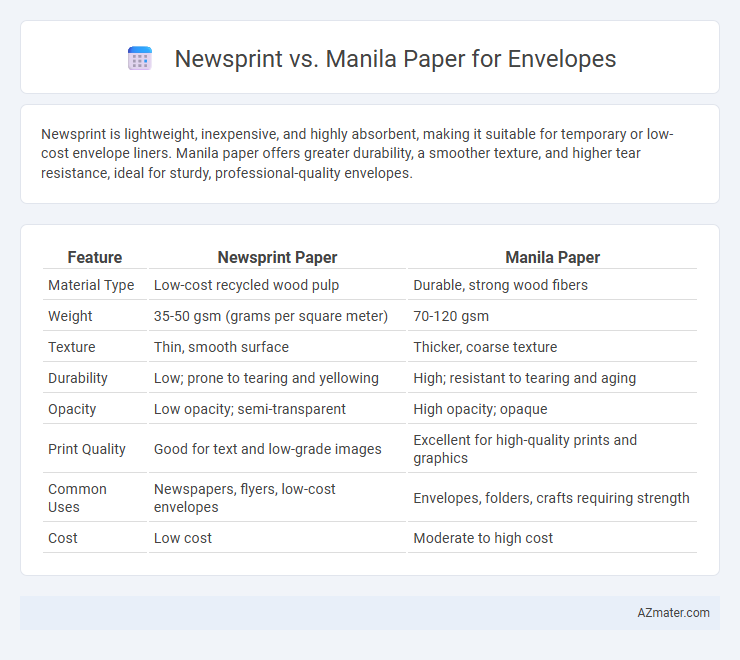Newsprint is lightweight, inexpensive, and highly absorbent, making it suitable for temporary or low-cost envelope liners. Manila paper offers greater durability, a smoother texture, and higher tear resistance, ideal for sturdy, professional-quality envelopes.
Table of Comparison
| Feature | Newsprint Paper | Manila Paper |
|---|---|---|
| Material Type | Low-cost recycled wood pulp | Durable, strong wood fibers |
| Weight | 35-50 gsm (grams per square meter) | 70-120 gsm |
| Texture | Thin, smooth surface | Thicker, coarse texture |
| Durability | Low; prone to tearing and yellowing | High; resistant to tearing and aging |
| Opacity | Low opacity; semi-transparent | High opacity; opaque |
| Print Quality | Good for text and low-grade images | Excellent for high-quality prints and graphics |
| Common Uses | Newspapers, flyers, low-cost envelopes | Envelopes, folders, crafts requiring strength |
| Cost | Low cost | Moderate to high cost |
Overview: Newsprint vs Manila Paper for Envelopes
Newsprint offers a lightweight, cost-effective option for envelope liners but lacks durability and resistance to tearing compared to Manila paper. Manila paper, made from strong fibers, provides enhanced strength and a smooth surface suitable for higher-quality envelopes requiring durability and a professional finish. Selecting between newsprint and Manila paper depends on the balance between budget constraints and the need for robust, premium packaging solutions.
Material Composition and Source Differences
Newsprint is primarily made from recycled wood pulp and contains lower-quality fibers, making it lightweight and cost-effective but less durable for envelopes. Manila paper is crafted from abaca fibers sourced from banana plants, offering superior strength, tear resistance, and a smoother surface ideal for high-quality envelope production. The distinct material composition and natural origin of manila paper contribute to its resilience and premium texture compared to the more economical and recycled nature of newsprint.
Durability and Strength Comparison
Newsprint paper is generally lightweight and less durable, making it prone to tearing and unsuitable for heavy or bulky envelopes, while Manila paper offers superior strength and durability due to its thicker fibers and higher weight. Manila paper's resilience makes it ideal for envelopes requiring secure handling, protection from wear, and longer shelf life. The tensile strength and tear resistance of Manila paper outperform newsprint, ensuring better protection during mailing and storage.
Cost Effectiveness and Affordability
Newsprint offers a highly cost-effective solution for envelope production due to its low price and wide availability, making it ideal for bulk mailing needs. Manila paper, while slightly more expensive, provides greater durability and a premium look that justifies the additional cost for business or formal correspondences. Choosing newsprint minimizes expenses for large volume distribution, whereas Manila paper balances affordability with enhanced quality and professional appearance.
Aesthetic Qualities and Appearance
Newsprint offers a rough texture and a dull, grayish tone that provides a rustic, vintage look ideal for casual or eco-friendly envelopes. Manila paper features a smooth surface with a warm, beige hue, delivering a polished and professional appearance perfect for formal correspondence. The choice between the two depends on the desired envelope aesthetic, where manila paper enhances elegance and newsprint emphasizes simplicity.
Printability and Surface Texture
Newsprint offers high absorbency and a rough surface texture that can compromise print sharpness and color vibrancy when used for envelopes. Manila paper features a smoother, more uniform surface that enhances print clarity and provides better ink adhesion, making it ideal for detailed graphics and text. The choice between newsprint and manila paper for envelope printing largely depends on the desired print quality and tactile feel, with manila paper excelling in professional, high-quality presentations.
Environmental Impact and Sustainability
Newsprint uses recycled fibers and has a lower manufacturing energy footprint, making it a more eco-friendly choice compared to Manila paper, which requires more raw materials and chemical processing. Manila paper is less biodegradable due to its chemical treatments, while newsprint decomposes faster, reducing landfill impact and supporting sustainability goals. Choosing newsprint for envelopes contributes to reducing deforestation and lowering carbon emissions in the paper production cycle.
Best Use Cases for Newsprint Envelopes
Newsprint envelopes excel for lightweight, low-cost mailing needs such as bulk flyers, promotional materials, and internal office correspondence due to their affordability and recyclability. Their breathable, flexible nature makes them ideal for temporary packaging where secure protection is not a priority. Newsprint envelopes are less suitable for documents requiring rigidity or moisture resistance, areas where manila paper envelopes, known for durability and sturdiness, perform better.
Ideal Applications for Manila Paper Envelopes
Manila paper envelopes are ideal for mailing documents, office correspondence, and lightweight materials due to their durability and smooth surface, which ensures easy writing and printing. Unlike newsprint, which is more fragile and best suited for temporary or bulk packaging, manila paper offers greater strength and resistance to tearing, making it suitable for professional and archival use. Its thicker texture and ability to withstand handling make manila paper envelopes preferred for important paperwork and secure document storage.
Choosing the Right Paper for Your Envelope Needs
Newsprint offers an economical and lightweight option for envelopes, ideal for bulk mailing and temporary correspondence, while Manila paper provides superior durability and a professional appearance suited for important documents and presentations. Manila paper's higher thickness and strength contribute to better protection during transit, reducing the risk of tearing or damage compared to the thinner, more fragile newsprint. Selecting between newsprint and Manila paper depends on factors such as budget, purpose, and required sturdiness, ensuring your envelope meets both functional and aesthetic needs.

Infographic: Newsprint vs Manila Paper for Envelope
 azmater.com
azmater.com